Human Resource Management Report: Business and HR Strategies Analysis
VerifiedAdded on 2020/06/04
|14
|4513
|30
Report
AI Summary
This report delves into the core aspects of Human Resource Management (HRM), exploring the critical relationship between business strategy and HR strategy. It critically evaluates various Strategic Human Resource Management (SHRM) models, including the Michigan and Harvard models, analyzing their strengths and weaknesses in different organizational contexts like NHS, John Lewis, and Sainsbury. The report then examines HR practices related to performance management and reward systems, assessing their impact on employee motivation and organizational effectiveness. Furthermore, it provides insights into designing and redesigning performance management systems to align with business goals. The second task explores employment relations, discussing the nature and theoretical perspectives, evaluating the roles of actors, and recommending mechanisms for enhancing employee participation and improving employment relations. The report concludes with a synthesis of the key findings and recommendations for effective HRM practices.
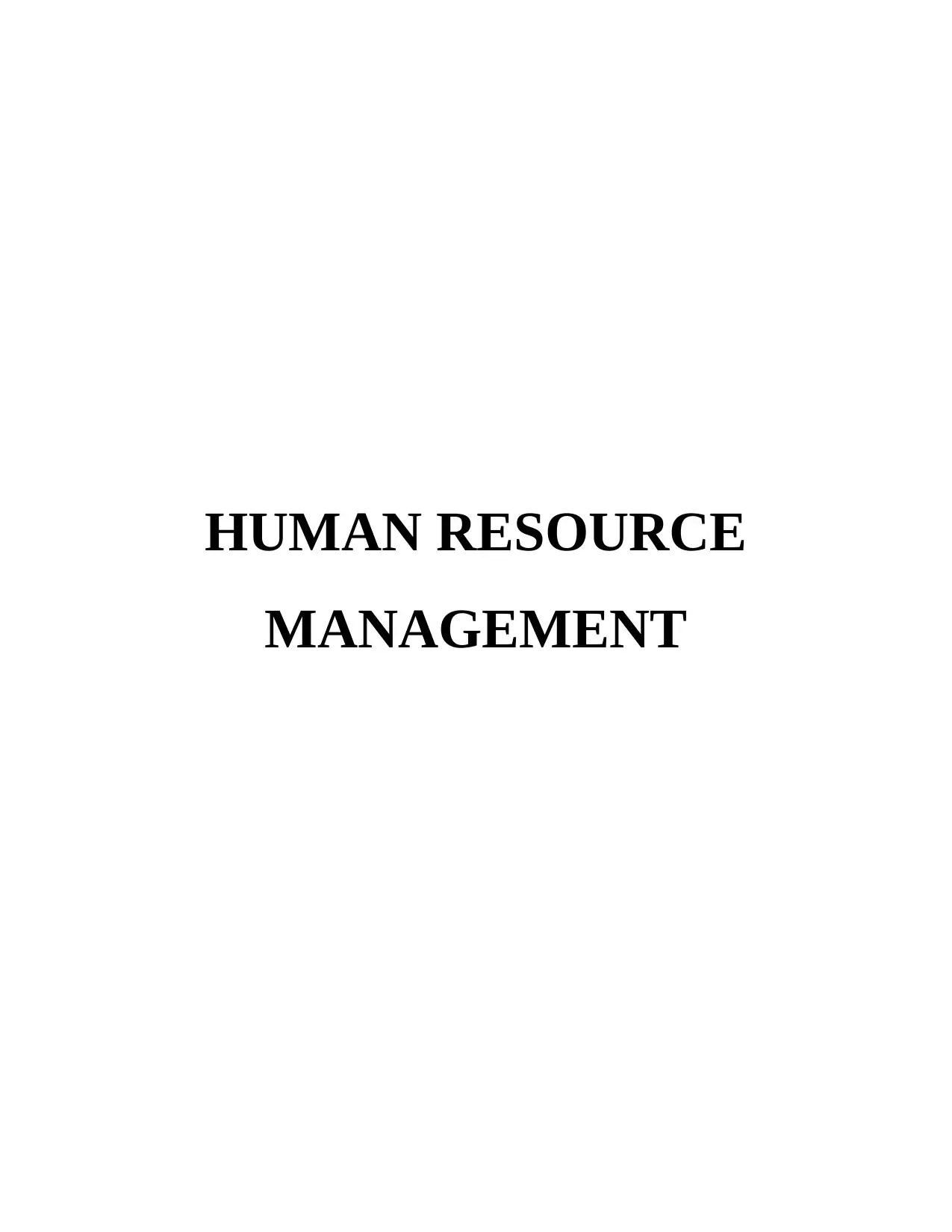
HUMAN RESOURCE
MANAGEMENT
MANAGEMENT
Paraphrase This Document
Need a fresh take? Get an instant paraphrase of this document with our AI Paraphraser
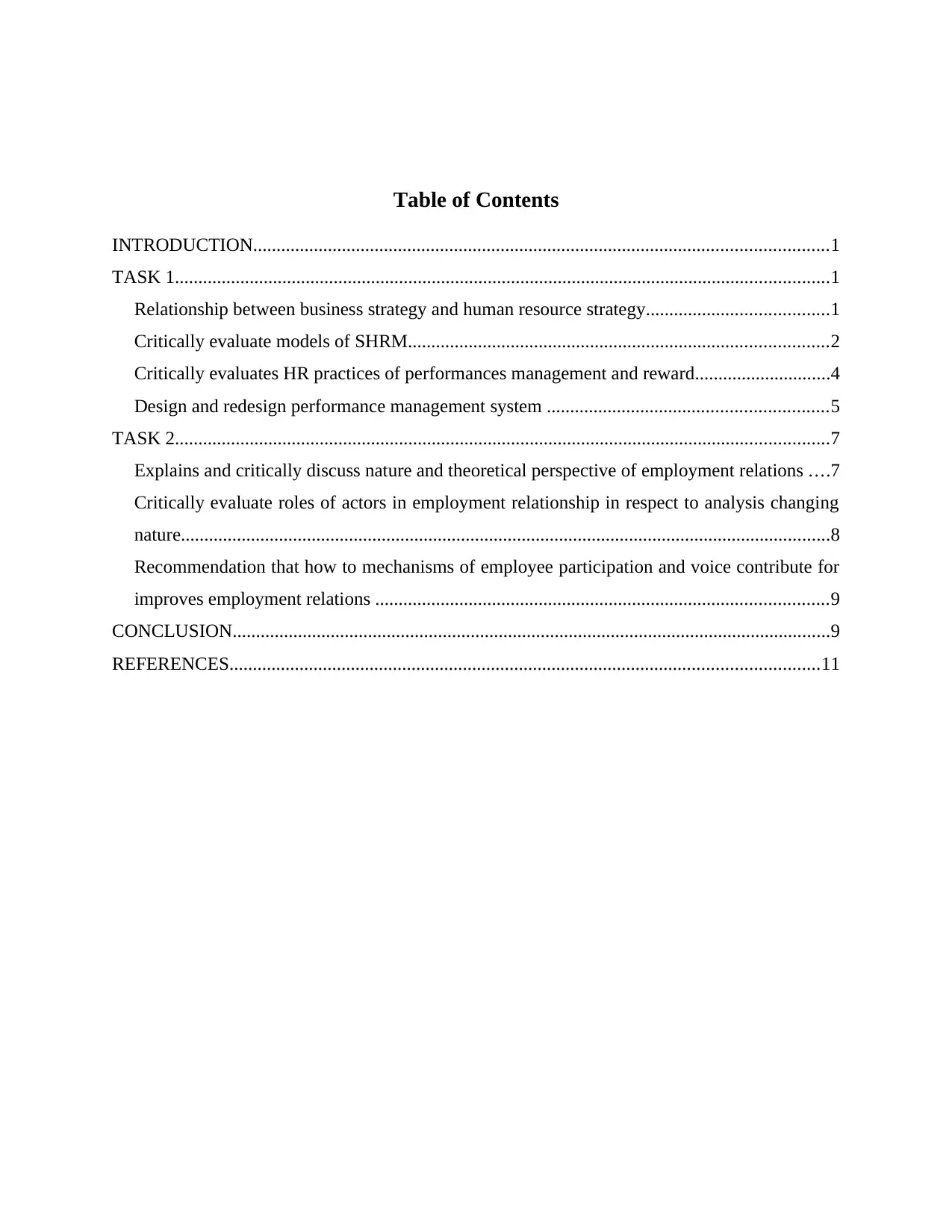
Table of Contents
INTRODUCTION...........................................................................................................................1
TASK 1............................................................................................................................................1
Relationship between business strategy and human resource strategy.......................................1
Critically evaluate models of SHRM..........................................................................................2
Critically evaluates HR practices of performances management and reward.............................4
Design and redesign performance management system ............................................................5
TASK 2............................................................................................................................................7
Explains and critically discuss nature and theoretical perspective of employment relations ....7
Critically evaluate roles of actors in employment relationship in respect to analysis changing
nature...........................................................................................................................................8
Recommendation that how to mechanisms of employee participation and voice contribute for
improves employment relations .................................................................................................9
CONCLUSION................................................................................................................................9
REFERENCES..............................................................................................................................11
INTRODUCTION...........................................................................................................................1
TASK 1............................................................................................................................................1
Relationship between business strategy and human resource strategy.......................................1
Critically evaluate models of SHRM..........................................................................................2
Critically evaluates HR practices of performances management and reward.............................4
Design and redesign performance management system ............................................................5
TASK 2............................................................................................................................................7
Explains and critically discuss nature and theoretical perspective of employment relations ....7
Critically evaluate roles of actors in employment relationship in respect to analysis changing
nature...........................................................................................................................................8
Recommendation that how to mechanisms of employee participation and voice contribute for
improves employment relations .................................................................................................9
CONCLUSION................................................................................................................................9
REFERENCES..............................................................................................................................11
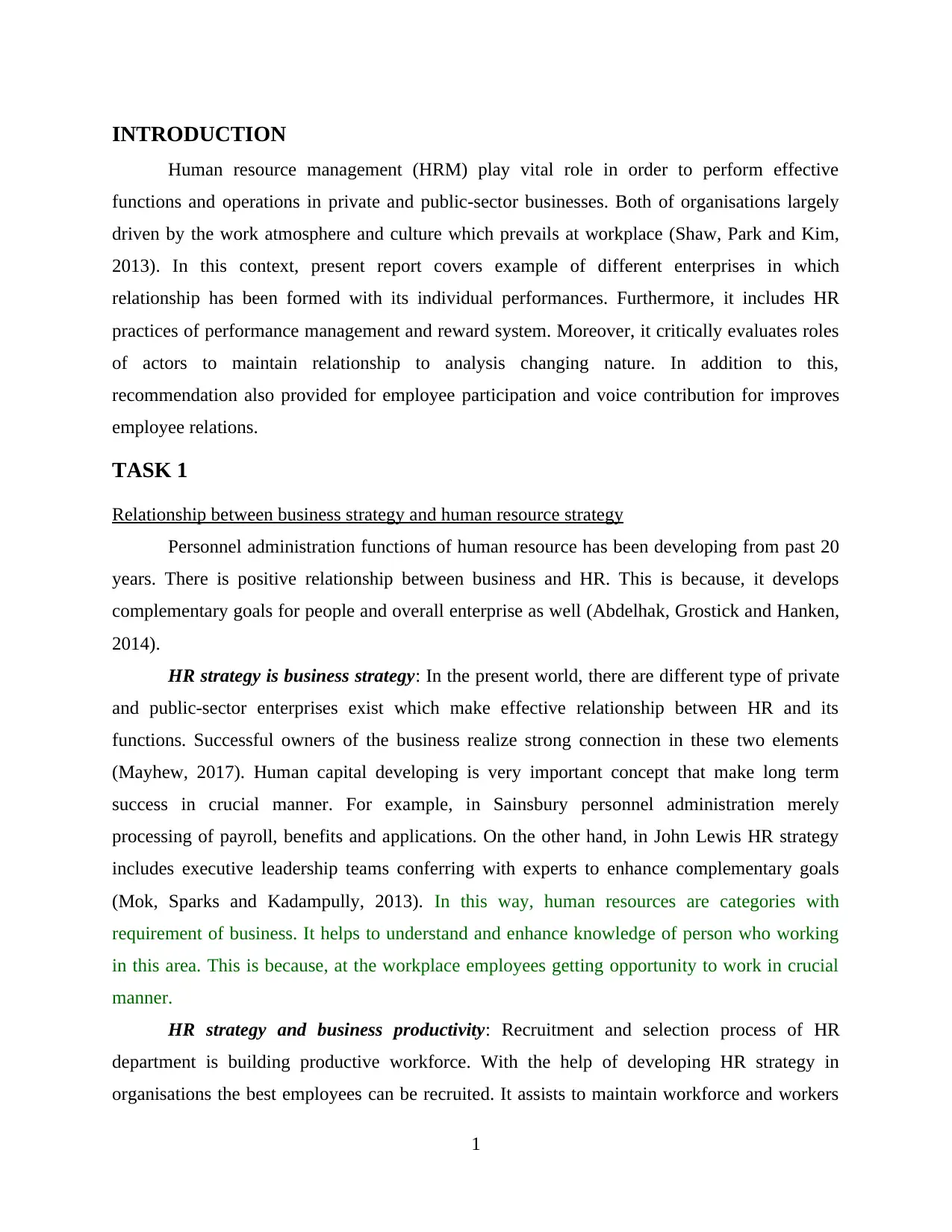
INTRODUCTION
Human resource management (HRM) play vital role in order to perform effective
functions and operations in private and public-sector businesses. Both of organisations largely
driven by the work atmosphere and culture which prevails at workplace (Shaw, Park and Kim,
2013). In this context, present report covers example of different enterprises in which
relationship has been formed with its individual performances. Furthermore, it includes HR
practices of performance management and reward system. Moreover, it critically evaluates roles
of actors to maintain relationship to analysis changing nature. In addition to this,
recommendation also provided for employee participation and voice contribution for improves
employee relations.
TASK 1
Relationship between business strategy and human resource strategy
Personnel administration functions of human resource has been developing from past 20
years. There is positive relationship between business and HR. This is because, it develops
complementary goals for people and overall enterprise as well (Abdelhak, Grostick and Hanken,
2014).
HR strategy is business strategy: In the present world, there are different type of private
and public-sector enterprises exist which make effective relationship between HR and its
functions. Successful owners of the business realize strong connection in these two elements
(Mayhew, 2017). Human capital developing is very important concept that make long term
success in crucial manner. For example, in Sainsbury personnel administration merely
processing of payroll, benefits and applications. On the other hand, in John Lewis HR strategy
includes executive leadership teams conferring with experts to enhance complementary goals
(Mok, Sparks and Kadampully, 2013). In this way, human resources are categories with
requirement of business. It helps to understand and enhance knowledge of person who working
in this area. This is because, at the workplace employees getting opportunity to work in crucial
manner.
HR strategy and business productivity: Recruitment and selection process of HR
department is building productive workforce. With the help of developing HR strategy in
organisations the best employees can be recruited. It assists to maintain workforce and workers
1
Human resource management (HRM) play vital role in order to perform effective
functions and operations in private and public-sector businesses. Both of organisations largely
driven by the work atmosphere and culture which prevails at workplace (Shaw, Park and Kim,
2013). In this context, present report covers example of different enterprises in which
relationship has been formed with its individual performances. Furthermore, it includes HR
practices of performance management and reward system. Moreover, it critically evaluates roles
of actors to maintain relationship to analysis changing nature. In addition to this,
recommendation also provided for employee participation and voice contribution for improves
employee relations.
TASK 1
Relationship between business strategy and human resource strategy
Personnel administration functions of human resource has been developing from past 20
years. There is positive relationship between business and HR. This is because, it develops
complementary goals for people and overall enterprise as well (Abdelhak, Grostick and Hanken,
2014).
HR strategy is business strategy: In the present world, there are different type of private
and public-sector enterprises exist which make effective relationship between HR and its
functions. Successful owners of the business realize strong connection in these two elements
(Mayhew, 2017). Human capital developing is very important concept that make long term
success in crucial manner. For example, in Sainsbury personnel administration merely
processing of payroll, benefits and applications. On the other hand, in John Lewis HR strategy
includes executive leadership teams conferring with experts to enhance complementary goals
(Mok, Sparks and Kadampully, 2013). In this way, human resources are categories with
requirement of business. It helps to understand and enhance knowledge of person who working
in this area. This is because, at the workplace employees getting opportunity to work in crucial
manner.
HR strategy and business productivity: Recruitment and selection process of HR
department is building productive workforce. With the help of developing HR strategy in
organisations the best employees can be recruited. It assists to maintain workforce and workers
1
⊘ This is a preview!⊘
Do you want full access?
Subscribe today to unlock all pages.

Trusted by 1+ million students worldwide
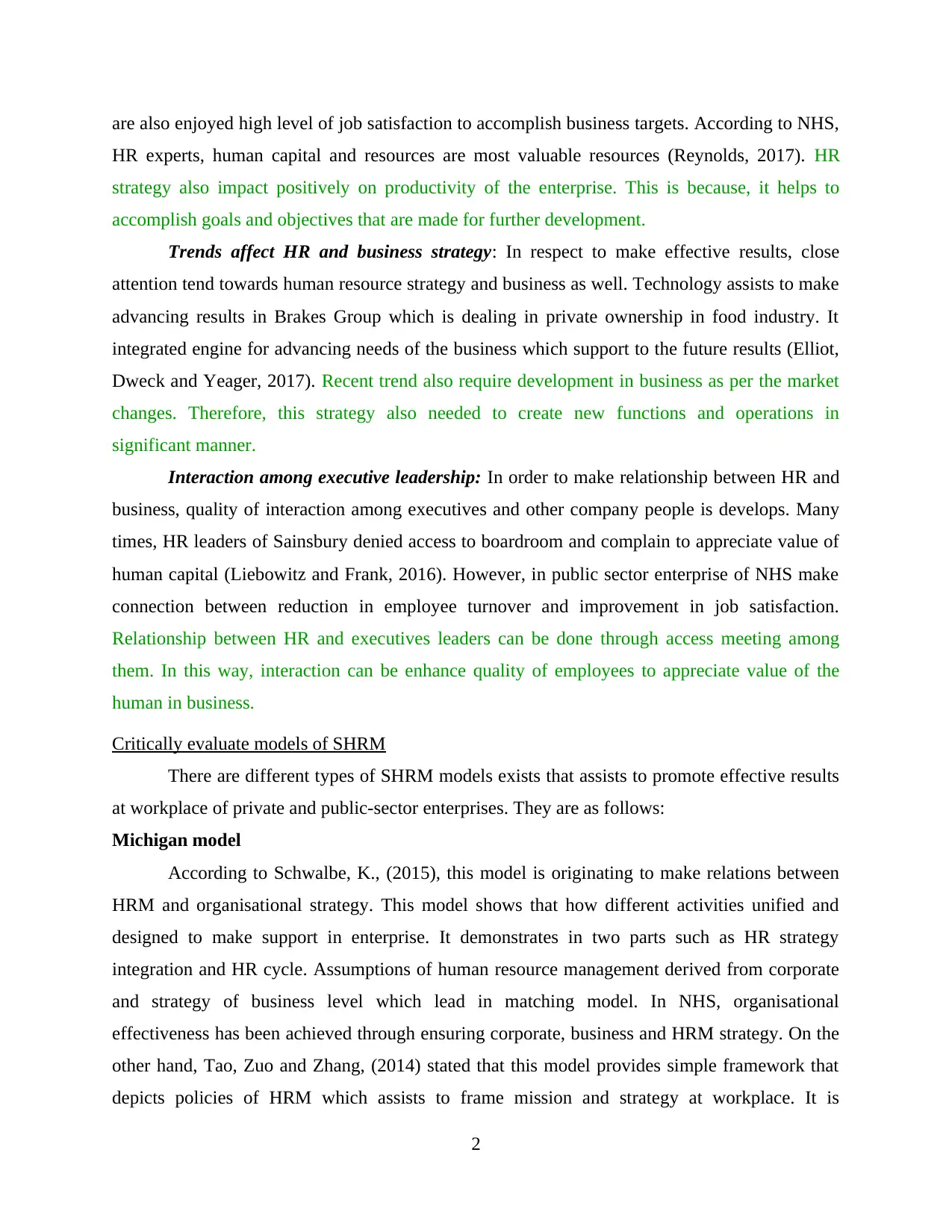
are also enjoyed high level of job satisfaction to accomplish business targets. According to NHS,
HR experts, human capital and resources are most valuable resources (Reynolds, 2017). HR
strategy also impact positively on productivity of the enterprise. This is because, it helps to
accomplish goals and objectives that are made for further development.
Trends affect HR and business strategy: In respect to make effective results, close
attention tend towards human resource strategy and business as well. Technology assists to make
advancing results in Brakes Group which is dealing in private ownership in food industry. It
integrated engine for advancing needs of the business which support to the future results (Elliot,
Dweck and Yeager, 2017). Recent trend also require development in business as per the market
changes. Therefore, this strategy also needed to create new functions and operations in
significant manner.
Interaction among executive leadership: In order to make relationship between HR and
business, quality of interaction among executives and other company people is develops. Many
times, HR leaders of Sainsbury denied access to boardroom and complain to appreciate value of
human capital (Liebowitz and Frank, 2016). However, in public sector enterprise of NHS make
connection between reduction in employee turnover and improvement in job satisfaction.
Relationship between HR and executives leaders can be done through access meeting among
them. In this way, interaction can be enhance quality of employees to appreciate value of the
human in business.
Critically evaluate models of SHRM
There are different types of SHRM models exists that assists to promote effective results
at workplace of private and public-sector enterprises. They are as follows:
Michigan model
According to Schwalbe, K., (2015), this model is originating to make relations between
HRM and organisational strategy. This model shows that how different activities unified and
designed to make support in enterprise. It demonstrates in two parts such as HR strategy
integration and HR cycle. Assumptions of human resource management derived from corporate
and strategy of business level which lead in matching model. In NHS, organisational
effectiveness has been achieved through ensuring corporate, business and HRM strategy. On the
other hand, Tao, Zuo and Zhang, (2014) stated that this model provides simple framework that
depicts policies of HRM which assists to frame mission and strategy at workplace. It is
2
HR experts, human capital and resources are most valuable resources (Reynolds, 2017). HR
strategy also impact positively on productivity of the enterprise. This is because, it helps to
accomplish goals and objectives that are made for further development.
Trends affect HR and business strategy: In respect to make effective results, close
attention tend towards human resource strategy and business as well. Technology assists to make
advancing results in Brakes Group which is dealing in private ownership in food industry. It
integrated engine for advancing needs of the business which support to the future results (Elliot,
Dweck and Yeager, 2017). Recent trend also require development in business as per the market
changes. Therefore, this strategy also needed to create new functions and operations in
significant manner.
Interaction among executive leadership: In order to make relationship between HR and
business, quality of interaction among executives and other company people is develops. Many
times, HR leaders of Sainsbury denied access to boardroom and complain to appreciate value of
human capital (Liebowitz and Frank, 2016). However, in public sector enterprise of NHS make
connection between reduction in employee turnover and improvement in job satisfaction.
Relationship between HR and executives leaders can be done through access meeting among
them. In this way, interaction can be enhance quality of employees to appreciate value of the
human in business.
Critically evaluate models of SHRM
There are different types of SHRM models exists that assists to promote effective results
at workplace of private and public-sector enterprises. They are as follows:
Michigan model
According to Schwalbe, K., (2015), this model is originating to make relations between
HRM and organisational strategy. This model shows that how different activities unified and
designed to make support in enterprise. It demonstrates in two parts such as HR strategy
integration and HR cycle. Assumptions of human resource management derived from corporate
and strategy of business level which lead in matching model. In NHS, organisational
effectiveness has been achieved through ensuring corporate, business and HRM strategy. On the
other hand, Tao, Zuo and Zhang, (2014) stated that this model provides simple framework that
depicts policies of HRM which assists to frame mission and strategy at workplace. It is
2
Paraphrase This Document
Need a fresh take? Get an instant paraphrase of this document with our AI Paraphraser
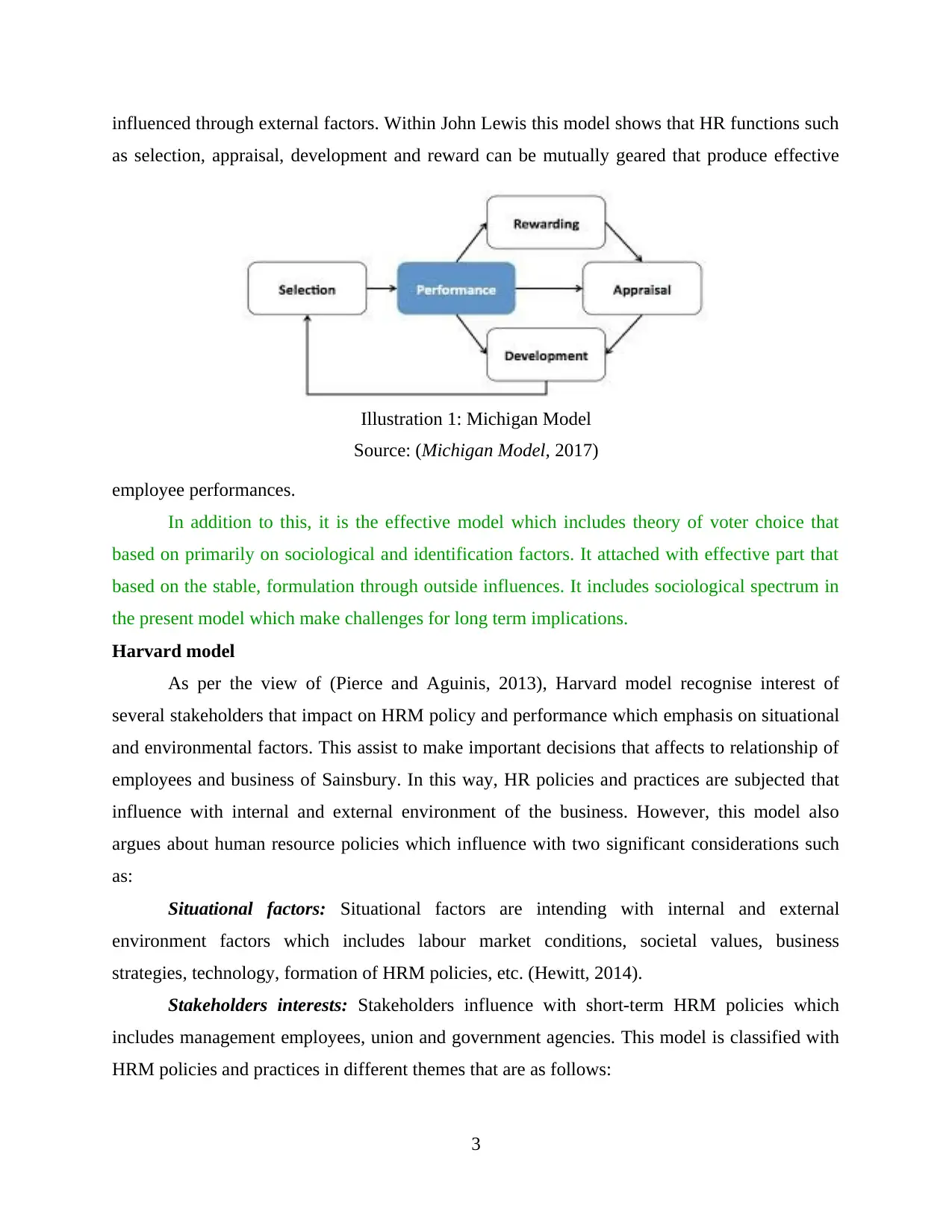
influenced through external factors. Within John Lewis this model shows that HR functions such
as selection, appraisal, development and reward can be mutually geared that produce effective
employee performances.
In addition to this, it is the effective model which includes theory of voter choice that
based on primarily on sociological and identification factors. It attached with effective part that
based on the stable, formulation through outside influences. It includes sociological spectrum in
the present model which make challenges for long term implications.
Harvard model
As per the view of (Pierce and Aguinis, 2013), Harvard model recognise interest of
several stakeholders that impact on HRM policy and performance which emphasis on situational
and environmental factors. This assist to make important decisions that affects to relationship of
employees and business of Sainsbury. In this way, HR policies and practices are subjected that
influence with internal and external environment of the business. However, this model also
argues about human resource policies which influence with two significant considerations such
as:
Situational factors: Situational factors are intending with internal and external
environment factors which includes labour market conditions, societal values, business
strategies, technology, formation of HRM policies, etc. (Hewitt, 2014).
Stakeholders interests: Stakeholders influence with short-term HRM policies which
includes management employees, union and government agencies. This model is classified with
HRM policies and practices in different themes that are as follows:
3
Illustration 1: Michigan Model
Source: (Michigan Model, 2017)
as selection, appraisal, development and reward can be mutually geared that produce effective
employee performances.
In addition to this, it is the effective model which includes theory of voter choice that
based on primarily on sociological and identification factors. It attached with effective part that
based on the stable, formulation through outside influences. It includes sociological spectrum in
the present model which make challenges for long term implications.
Harvard model
As per the view of (Pierce and Aguinis, 2013), Harvard model recognise interest of
several stakeholders that impact on HRM policy and performance which emphasis on situational
and environmental factors. This assist to make important decisions that affects to relationship of
employees and business of Sainsbury. In this way, HR policies and practices are subjected that
influence with internal and external environment of the business. However, this model also
argues about human resource policies which influence with two significant considerations such
as:
Situational factors: Situational factors are intending with internal and external
environment factors which includes labour market conditions, societal values, business
strategies, technology, formation of HRM policies, etc. (Hewitt, 2014).
Stakeholders interests: Stakeholders influence with short-term HRM policies which
includes management employees, union and government agencies. This model is classified with
HRM policies and practices in different themes that are as follows:
3
Illustration 1: Michigan Model
Source: (Michigan Model, 2017)
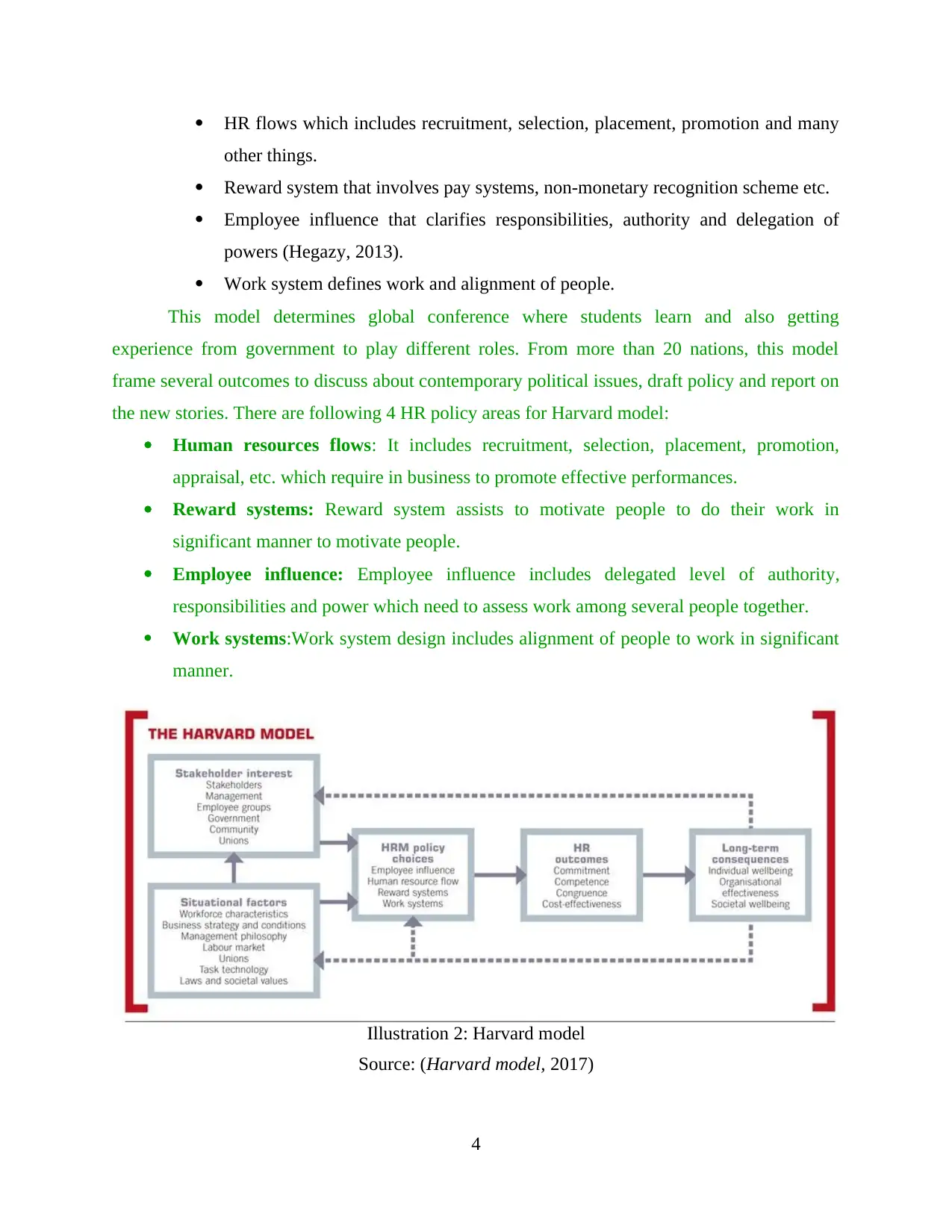
HR flows which includes recruitment, selection, placement, promotion and many
other things.
Reward system that involves pay systems, non-monetary recognition scheme etc.
Employee influence that clarifies responsibilities, authority and delegation of
powers (Hegazy, 2013).
Work system defines work and alignment of people.
This model determines global conference where students learn and also getting
experience from government to play different roles. From more than 20 nations, this model
frame several outcomes to discuss about contemporary political issues, draft policy and report on
the new stories. There are following 4 HR policy areas for Harvard model:
Human resources flows: It includes recruitment, selection, placement, promotion,
appraisal, etc. which require in business to promote effective performances.
Reward systems: Reward system assists to motivate people to do their work in
significant manner to motivate people.
Employee influence: Employee influence includes delegated level of authority,
responsibilities and power which need to assess work among several people together.
Work systems:Work system design includes alignment of people to work in significant
manner.
4
Illustration 2: Harvard model
Source: (Harvard model, 2017)
other things.
Reward system that involves pay systems, non-monetary recognition scheme etc.
Employee influence that clarifies responsibilities, authority and delegation of
powers (Hegazy, 2013).
Work system defines work and alignment of people.
This model determines global conference where students learn and also getting
experience from government to play different roles. From more than 20 nations, this model
frame several outcomes to discuss about contemporary political issues, draft policy and report on
the new stories. There are following 4 HR policy areas for Harvard model:
Human resources flows: It includes recruitment, selection, placement, promotion,
appraisal, etc. which require in business to promote effective performances.
Reward systems: Reward system assists to motivate people to do their work in
significant manner to motivate people.
Employee influence: Employee influence includes delegated level of authority,
responsibilities and power which need to assess work among several people together.
Work systems:Work system design includes alignment of people to work in significant
manner.
4
Illustration 2: Harvard model
Source: (Harvard model, 2017)
⊘ This is a preview!⊘
Do you want full access?
Subscribe today to unlock all pages.

Trusted by 1+ million students worldwide
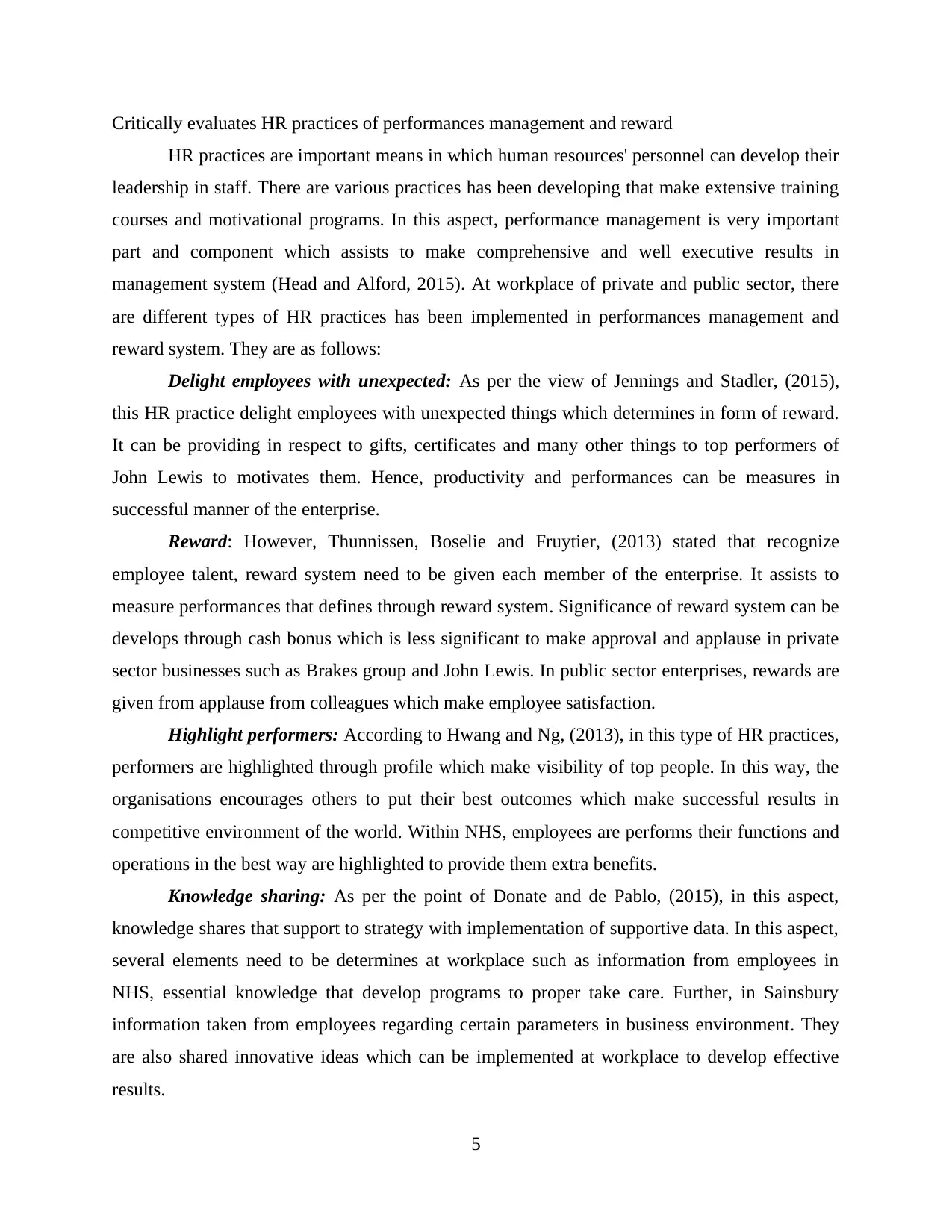
Critically evaluates HR practices of performances management and reward
HR practices are important means in which human resources' personnel can develop their
leadership in staff. There are various practices has been developing that make extensive training
courses and motivational programs. In this aspect, performance management is very important
part and component which assists to make comprehensive and well executive results in
management system (Head and Alford, 2015). At workplace of private and public sector, there
are different types of HR practices has been implemented in performances management and
reward system. They are as follows:
Delight employees with unexpected: As per the view of Jennings and Stadler, (2015),
this HR practice delight employees with unexpected things which determines in form of reward.
It can be providing in respect to gifts, certificates and many other things to top performers of
John Lewis to motivates them. Hence, productivity and performances can be measures in
successful manner of the enterprise.
Reward: However, Thunnissen, Boselie and Fruytier, (2013) stated that recognize
employee talent, reward system need to be given each member of the enterprise. It assists to
measure performances that defines through reward system. Significance of reward system can be
develops through cash bonus which is less significant to make approval and applause in private
sector businesses such as Brakes group and John Lewis. In public sector enterprises, rewards are
given from applause from colleagues which make employee satisfaction.
Highlight performers: According to Hwang and Ng, (2013), in this type of HR practices,
performers are highlighted through profile which make visibility of top people. In this way, the
organisations encourages others to put their best outcomes which make successful results in
competitive environment of the world. Within NHS, employees are performs their functions and
operations in the best way are highlighted to provide them extra benefits.
Knowledge sharing: As per the point of Donate and de Pablo, (2015), in this aspect,
knowledge shares that support to strategy with implementation of supportive data. In this aspect,
several elements need to be determines at workplace such as information from employees in
NHS, essential knowledge that develop programs to proper take care. Further, in Sainsbury
information taken from employees regarding certain parameters in business environment. They
are also shared innovative ideas which can be implemented at workplace to develop effective
results.
5
HR practices are important means in which human resources' personnel can develop their
leadership in staff. There are various practices has been developing that make extensive training
courses and motivational programs. In this aspect, performance management is very important
part and component which assists to make comprehensive and well executive results in
management system (Head and Alford, 2015). At workplace of private and public sector, there
are different types of HR practices has been implemented in performances management and
reward system. They are as follows:
Delight employees with unexpected: As per the view of Jennings and Stadler, (2015),
this HR practice delight employees with unexpected things which determines in form of reward.
It can be providing in respect to gifts, certificates and many other things to top performers of
John Lewis to motivates them. Hence, productivity and performances can be measures in
successful manner of the enterprise.
Reward: However, Thunnissen, Boselie and Fruytier, (2013) stated that recognize
employee talent, reward system need to be given each member of the enterprise. It assists to
measure performances that defines through reward system. Significance of reward system can be
develops through cash bonus which is less significant to make approval and applause in private
sector businesses such as Brakes group and John Lewis. In public sector enterprises, rewards are
given from applause from colleagues which make employee satisfaction.
Highlight performers: According to Hwang and Ng, (2013), in this type of HR practices,
performers are highlighted through profile which make visibility of top people. In this way, the
organisations encourages others to put their best outcomes which make successful results in
competitive environment of the world. Within NHS, employees are performs their functions and
operations in the best way are highlighted to provide them extra benefits.
Knowledge sharing: As per the point of Donate and de Pablo, (2015), in this aspect,
knowledge shares that support to strategy with implementation of supportive data. In this aspect,
several elements need to be determines at workplace such as information from employees in
NHS, essential knowledge that develop programs to proper take care. Further, in Sainsbury
information taken from employees regarding certain parameters in business environment. They
are also shared innovative ideas which can be implemented at workplace to develop effective
results.
5
Paraphrase This Document
Need a fresh take? Get an instant paraphrase of this document with our AI Paraphraser
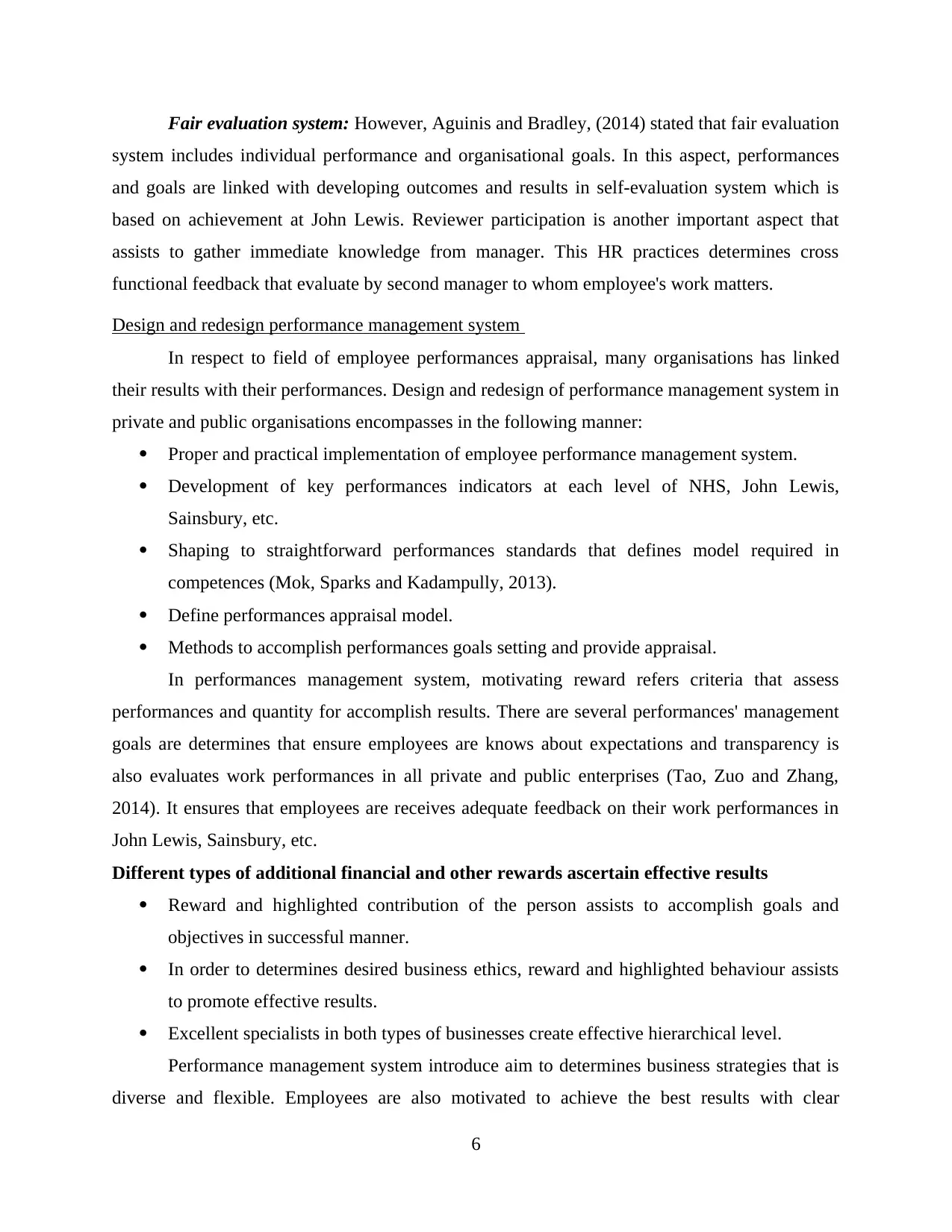
Fair evaluation system: However, Aguinis and Bradley, (2014) stated that fair evaluation
system includes individual performance and organisational goals. In this aspect, performances
and goals are linked with developing outcomes and results in self-evaluation system which is
based on achievement at John Lewis. Reviewer participation is another important aspect that
assists to gather immediate knowledge from manager. This HR practices determines cross
functional feedback that evaluate by second manager to whom employee's work matters.
Design and redesign performance management system
In respect to field of employee performances appraisal, many organisations has linked
their results with their performances. Design and redesign of performance management system in
private and public organisations encompasses in the following manner:
Proper and practical implementation of employee performance management system.
Development of key performances indicators at each level of NHS, John Lewis,
Sainsbury, etc.
Shaping to straightforward performances standards that defines model required in
competences (Mok, Sparks and Kadampully, 2013).
Define performances appraisal model.
Methods to accomplish performances goals setting and provide appraisal.
In performances management system, motivating reward refers criteria that assess
performances and quantity for accomplish results. There are several performances' management
goals are determines that ensure employees are knows about expectations and transparency is
also evaluates work performances in all private and public enterprises (Tao, Zuo and Zhang,
2014). It ensures that employees are receives adequate feedback on their work performances in
John Lewis, Sainsbury, etc.
Different types of additional financial and other rewards ascertain effective results
Reward and highlighted contribution of the person assists to accomplish goals and
objectives in successful manner.
In order to determines desired business ethics, reward and highlighted behaviour assists
to promote effective results.
Excellent specialists in both types of businesses create effective hierarchical level.
Performance management system introduce aim to determines business strategies that is
diverse and flexible. Employees are also motivated to achieve the best results with clear
6
system includes individual performance and organisational goals. In this aspect, performances
and goals are linked with developing outcomes and results in self-evaluation system which is
based on achievement at John Lewis. Reviewer participation is another important aspect that
assists to gather immediate knowledge from manager. This HR practices determines cross
functional feedback that evaluate by second manager to whom employee's work matters.
Design and redesign performance management system
In respect to field of employee performances appraisal, many organisations has linked
their results with their performances. Design and redesign of performance management system in
private and public organisations encompasses in the following manner:
Proper and practical implementation of employee performance management system.
Development of key performances indicators at each level of NHS, John Lewis,
Sainsbury, etc.
Shaping to straightforward performances standards that defines model required in
competences (Mok, Sparks and Kadampully, 2013).
Define performances appraisal model.
Methods to accomplish performances goals setting and provide appraisal.
In performances management system, motivating reward refers criteria that assess
performances and quantity for accomplish results. There are several performances' management
goals are determines that ensure employees are knows about expectations and transparency is
also evaluates work performances in all private and public enterprises (Tao, Zuo and Zhang,
2014). It ensures that employees are receives adequate feedback on their work performances in
John Lewis, Sainsbury, etc.
Different types of additional financial and other rewards ascertain effective results
Reward and highlighted contribution of the person assists to accomplish goals and
objectives in successful manner.
In order to determines desired business ethics, reward and highlighted behaviour assists
to promote effective results.
Excellent specialists in both types of businesses create effective hierarchical level.
Performance management system introduce aim to determines business strategies that is
diverse and flexible. Employees are also motivated to achieve the best results with clear
6
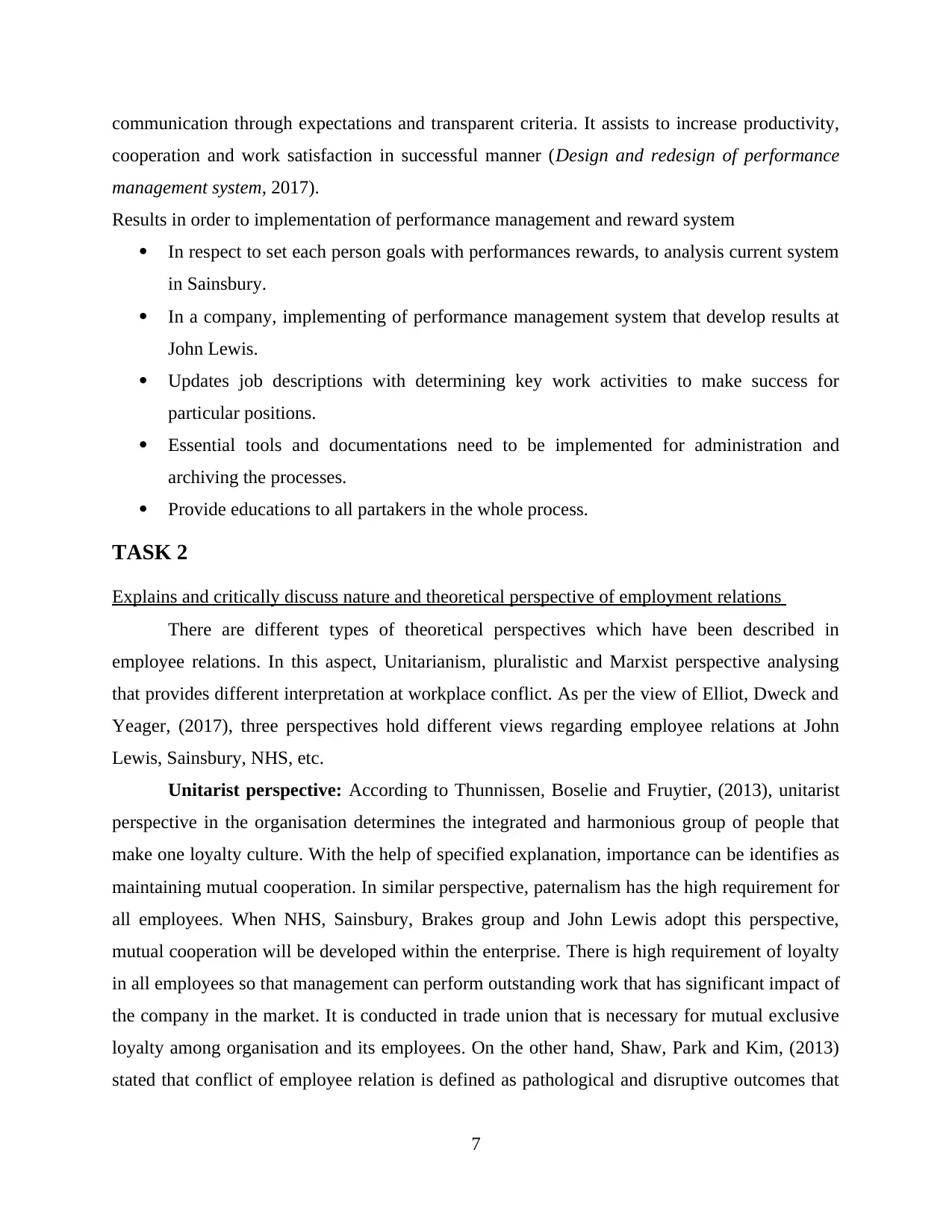
communication through expectations and transparent criteria. It assists to increase productivity,
cooperation and work satisfaction in successful manner (Design and redesign of performance
management system, 2017).
Results in order to implementation of performance management and reward system
In respect to set each person goals with performances rewards, to analysis current system
in Sainsbury.
In a company, implementing of performance management system that develop results at
John Lewis.
Updates job descriptions with determining key work activities to make success for
particular positions.
Essential tools and documentations need to be implemented for administration and
archiving the processes.
Provide educations to all partakers in the whole process.
TASK 2
Explains and critically discuss nature and theoretical perspective of employment relations
There are different types of theoretical perspectives which have been described in
employee relations. In this aspect, Unitarianism, pluralistic and Marxist perspective analysing
that provides different interpretation at workplace conflict. As per the view of Elliot, Dweck and
Yeager, (2017), three perspectives hold different views regarding employee relations at John
Lewis, Sainsbury, NHS, etc.
Unitarist perspective: According to Thunnissen, Boselie and Fruytier, (2013), unitarist
perspective in the organisation determines the integrated and harmonious group of people that
make one loyalty culture. With the help of specified explanation, importance can be identifies as
maintaining mutual cooperation. In similar perspective, paternalism has the high requirement for
all employees. When NHS, Sainsbury, Brakes group and John Lewis adopt this perspective,
mutual cooperation will be developed within the enterprise. There is high requirement of loyalty
in all employees so that management can perform outstanding work that has significant impact of
the company in the market. It is conducted in trade union that is necessary for mutual exclusive
loyalty among organisation and its employees. On the other hand, Shaw, Park and Kim, (2013)
stated that conflict of employee relation is defined as pathological and disruptive outcomes that
7
cooperation and work satisfaction in successful manner (Design and redesign of performance
management system, 2017).
Results in order to implementation of performance management and reward system
In respect to set each person goals with performances rewards, to analysis current system
in Sainsbury.
In a company, implementing of performance management system that develop results at
John Lewis.
Updates job descriptions with determining key work activities to make success for
particular positions.
Essential tools and documentations need to be implemented for administration and
archiving the processes.
Provide educations to all partakers in the whole process.
TASK 2
Explains and critically discuss nature and theoretical perspective of employment relations
There are different types of theoretical perspectives which have been described in
employee relations. In this aspect, Unitarianism, pluralistic and Marxist perspective analysing
that provides different interpretation at workplace conflict. As per the view of Elliot, Dweck and
Yeager, (2017), three perspectives hold different views regarding employee relations at John
Lewis, Sainsbury, NHS, etc.
Unitarist perspective: According to Thunnissen, Boselie and Fruytier, (2013), unitarist
perspective in the organisation determines the integrated and harmonious group of people that
make one loyalty culture. With the help of specified explanation, importance can be identifies as
maintaining mutual cooperation. In similar perspective, paternalism has the high requirement for
all employees. When NHS, Sainsbury, Brakes group and John Lewis adopt this perspective,
mutual cooperation will be developed within the enterprise. There is high requirement of loyalty
in all employees so that management can perform outstanding work that has significant impact of
the company in the market. It is conducted in trade union that is necessary for mutual exclusive
loyalty among organisation and its employees. On the other hand, Shaw, Park and Kim, (2013)
stated that conflict of employee relation is defined as pathological and disruptive outcomes that
7
⊘ This is a preview!⊘
Do you want full access?
Subscribe today to unlock all pages.

Trusted by 1+ million students worldwide
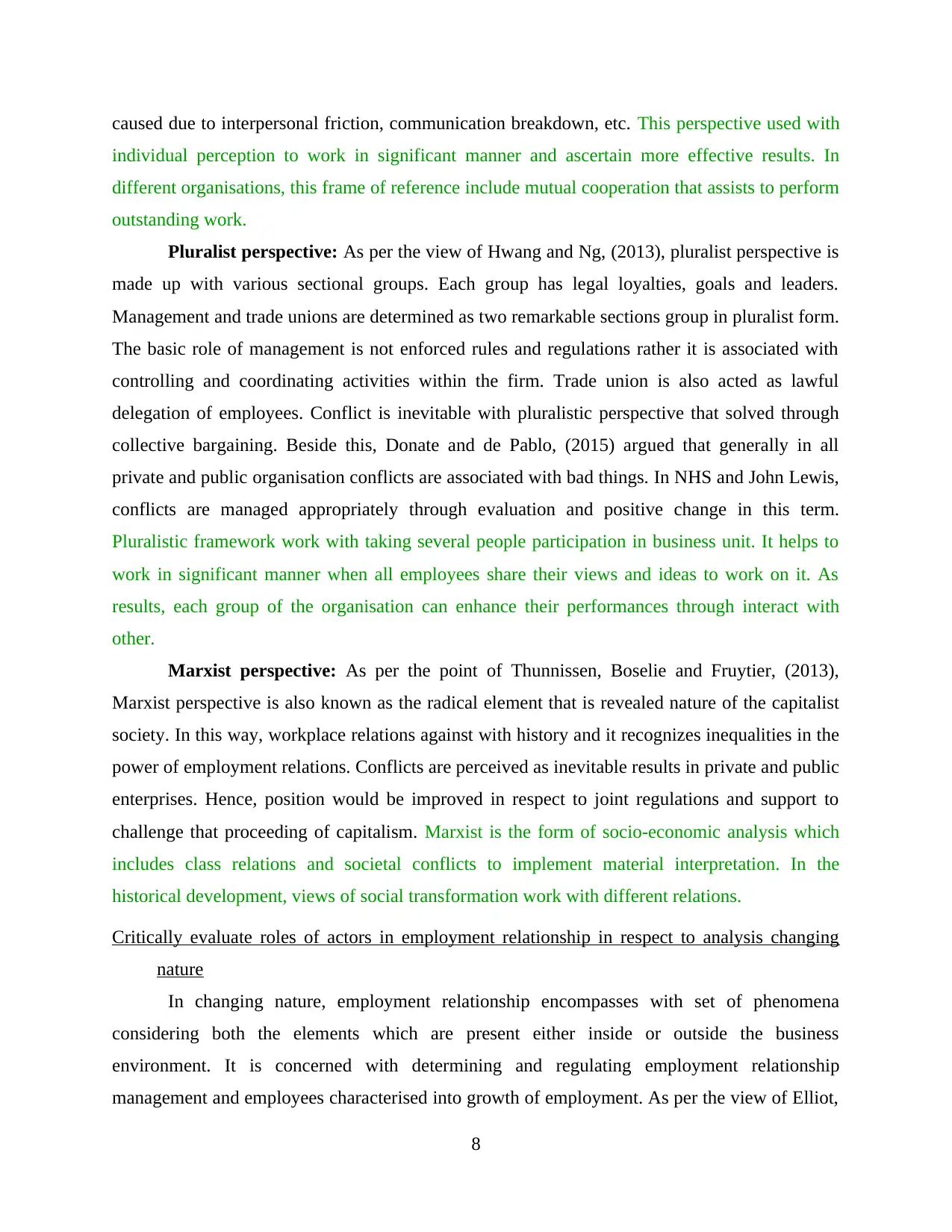
caused due to interpersonal friction, communication breakdown, etc. This perspective used with
individual perception to work in significant manner and ascertain more effective results. In
different organisations, this frame of reference include mutual cooperation that assists to perform
outstanding work.
Pluralist perspective: As per the view of Hwang and Ng, (2013), pluralist perspective is
made up with various sectional groups. Each group has legal loyalties, goals and leaders.
Management and trade unions are determined as two remarkable sections group in pluralist form.
The basic role of management is not enforced rules and regulations rather it is associated with
controlling and coordinating activities within the firm. Trade union is also acted as lawful
delegation of employees. Conflict is inevitable with pluralistic perspective that solved through
collective bargaining. Beside this, Donate and de Pablo, (2015) argued that generally in all
private and public organisation conflicts are associated with bad things. In NHS and John Lewis,
conflicts are managed appropriately through evaluation and positive change in this term.
Pluralistic framework work with taking several people participation in business unit. It helps to
work in significant manner when all employees share their views and ideas to work on it. As
results, each group of the organisation can enhance their performances through interact with
other.
Marxist perspective: As per the point of Thunnissen, Boselie and Fruytier, (2013),
Marxist perspective is also known as the radical element that is revealed nature of the capitalist
society. In this way, workplace relations against with history and it recognizes inequalities in the
power of employment relations. Conflicts are perceived as inevitable results in private and public
enterprises. Hence, position would be improved in respect to joint regulations and support to
challenge that proceeding of capitalism. Marxist is the form of socio-economic analysis which
includes class relations and societal conflicts to implement material interpretation. In the
historical development, views of social transformation work with different relations.
Critically evaluate roles of actors in employment relationship in respect to analysis changing
nature
In changing nature, employment relationship encompasses with set of phenomena
considering both the elements which are present either inside or outside the business
environment. It is concerned with determining and regulating employment relationship
management and employees characterised into growth of employment. As per the view of Elliot,
8
individual perception to work in significant manner and ascertain more effective results. In
different organisations, this frame of reference include mutual cooperation that assists to perform
outstanding work.
Pluralist perspective: As per the view of Hwang and Ng, (2013), pluralist perspective is
made up with various sectional groups. Each group has legal loyalties, goals and leaders.
Management and trade unions are determined as two remarkable sections group in pluralist form.
The basic role of management is not enforced rules and regulations rather it is associated with
controlling and coordinating activities within the firm. Trade union is also acted as lawful
delegation of employees. Conflict is inevitable with pluralistic perspective that solved through
collective bargaining. Beside this, Donate and de Pablo, (2015) argued that generally in all
private and public organisation conflicts are associated with bad things. In NHS and John Lewis,
conflicts are managed appropriately through evaluation and positive change in this term.
Pluralistic framework work with taking several people participation in business unit. It helps to
work in significant manner when all employees share their views and ideas to work on it. As
results, each group of the organisation can enhance their performances through interact with
other.
Marxist perspective: As per the point of Thunnissen, Boselie and Fruytier, (2013),
Marxist perspective is also known as the radical element that is revealed nature of the capitalist
society. In this way, workplace relations against with history and it recognizes inequalities in the
power of employment relations. Conflicts are perceived as inevitable results in private and public
enterprises. Hence, position would be improved in respect to joint regulations and support to
challenge that proceeding of capitalism. Marxist is the form of socio-economic analysis which
includes class relations and societal conflicts to implement material interpretation. In the
historical development, views of social transformation work with different relations.
Critically evaluate roles of actors in employment relationship in respect to analysis changing
nature
In changing nature, employment relationship encompasses with set of phenomena
considering both the elements which are present either inside or outside the business
environment. It is concerned with determining and regulating employment relationship
management and employees characterised into growth of employment. As per the view of Elliot,
8
Paraphrase This Document
Need a fresh take? Get an instant paraphrase of this document with our AI Paraphraser
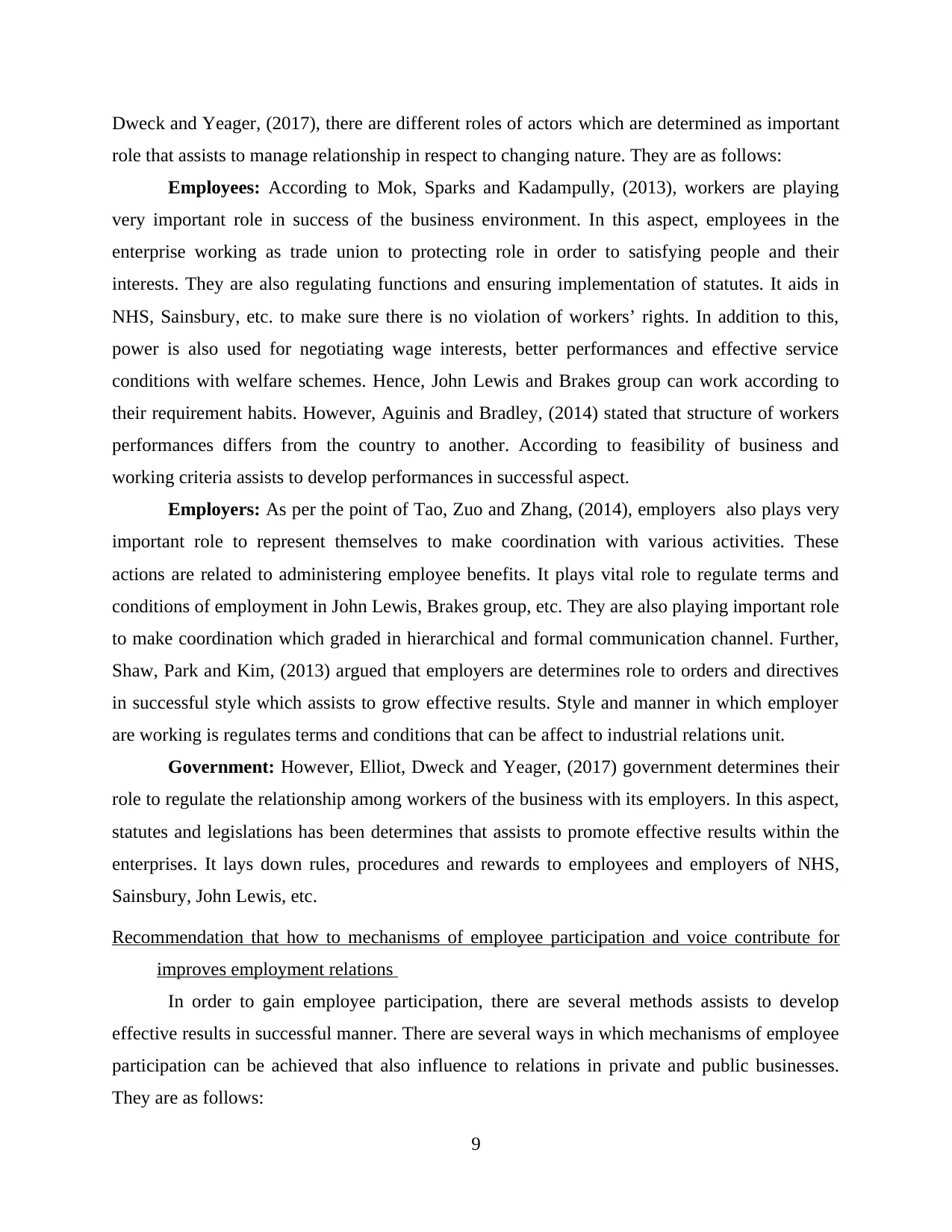
Dweck and Yeager, (2017), there are different roles of actors which are determined as important
role that assists to manage relationship in respect to changing nature. They are as follows:
Employees: According to Mok, Sparks and Kadampully, (2013), workers are playing
very important role in success of the business environment. In this aspect, employees in the
enterprise working as trade union to protecting role in order to satisfying people and their
interests. They are also regulating functions and ensuring implementation of statutes. It aids in
NHS, Sainsbury, etc. to make sure there is no violation of workers’ rights. In addition to this,
power is also used for negotiating wage interests, better performances and effective service
conditions with welfare schemes. Hence, John Lewis and Brakes group can work according to
their requirement habits. However, Aguinis and Bradley, (2014) stated that structure of workers
performances differs from the country to another. According to feasibility of business and
working criteria assists to develop performances in successful aspect.
Employers: As per the point of Tao, Zuo and Zhang, (2014), employers also plays very
important role to represent themselves to make coordination with various activities. These
actions are related to administering employee benefits. It plays vital role to regulate terms and
conditions of employment in John Lewis, Brakes group, etc. They are also playing important role
to make coordination which graded in hierarchical and formal communication channel. Further,
Shaw, Park and Kim, (2013) argued that employers are determines role to orders and directives
in successful style which assists to grow effective results. Style and manner in which employer
are working is regulates terms and conditions that can be affect to industrial relations unit.
Government: However, Elliot, Dweck and Yeager, (2017) government determines their
role to regulate the relationship among workers of the business with its employers. In this aspect,
statutes and legislations has been determines that assists to promote effective results within the
enterprises. It lays down rules, procedures and rewards to employees and employers of NHS,
Sainsbury, John Lewis, etc.
Recommendation that how to mechanisms of employee participation and voice contribute for
improves employment relations
In order to gain employee participation, there are several methods assists to develop
effective results in successful manner. There are several ways in which mechanisms of employee
participation can be achieved that also influence to relations in private and public businesses.
They are as follows:
9
role that assists to manage relationship in respect to changing nature. They are as follows:
Employees: According to Mok, Sparks and Kadampully, (2013), workers are playing
very important role in success of the business environment. In this aspect, employees in the
enterprise working as trade union to protecting role in order to satisfying people and their
interests. They are also regulating functions and ensuring implementation of statutes. It aids in
NHS, Sainsbury, etc. to make sure there is no violation of workers’ rights. In addition to this,
power is also used for negotiating wage interests, better performances and effective service
conditions with welfare schemes. Hence, John Lewis and Brakes group can work according to
their requirement habits. However, Aguinis and Bradley, (2014) stated that structure of workers
performances differs from the country to another. According to feasibility of business and
working criteria assists to develop performances in successful aspect.
Employers: As per the point of Tao, Zuo and Zhang, (2014), employers also plays very
important role to represent themselves to make coordination with various activities. These
actions are related to administering employee benefits. It plays vital role to regulate terms and
conditions of employment in John Lewis, Brakes group, etc. They are also playing important role
to make coordination which graded in hierarchical and formal communication channel. Further,
Shaw, Park and Kim, (2013) argued that employers are determines role to orders and directives
in successful style which assists to grow effective results. Style and manner in which employer
are working is regulates terms and conditions that can be affect to industrial relations unit.
Government: However, Elliot, Dweck and Yeager, (2017) government determines their
role to regulate the relationship among workers of the business with its employers. In this aspect,
statutes and legislations has been determines that assists to promote effective results within the
enterprises. It lays down rules, procedures and rewards to employees and employers of NHS,
Sainsbury, John Lewis, etc.
Recommendation that how to mechanisms of employee participation and voice contribute for
improves employment relations
In order to gain employee participation, there are several methods assists to develop
effective results in successful manner. There are several ways in which mechanisms of employee
participation can be achieved that also influence to relations in private and public businesses.
They are as follows:
9
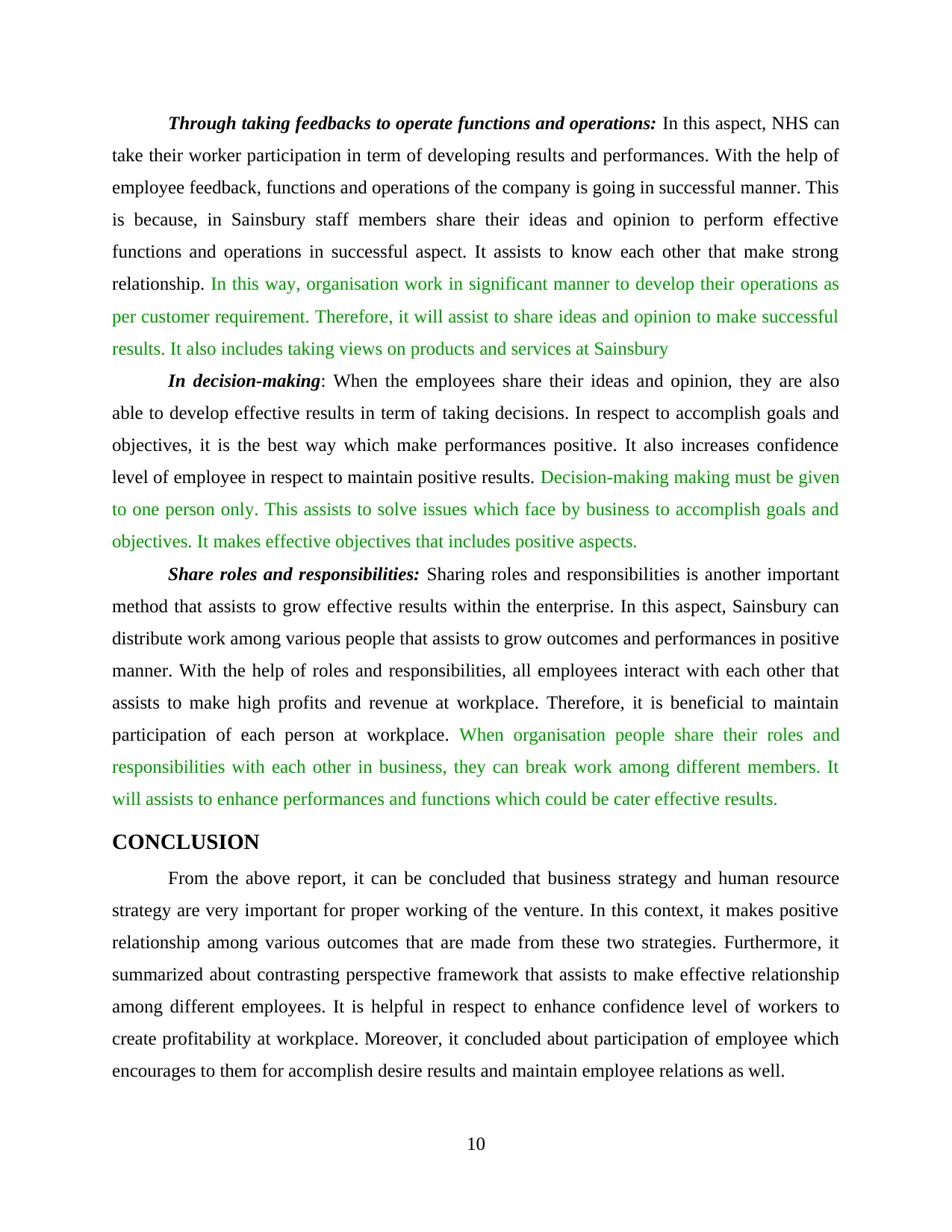
Through taking feedbacks to operate functions and operations: In this aspect, NHS can
take their worker participation in term of developing results and performances. With the help of
employee feedback, functions and operations of the company is going in successful manner. This
is because, in Sainsbury staff members share their ideas and opinion to perform effective
functions and operations in successful aspect. It assists to know each other that make strong
relationship. In this way, organisation work in significant manner to develop their operations as
per customer requirement. Therefore, it will assist to share ideas and opinion to make successful
results. It also includes taking views on products and services at Sainsbury
In decision-making: When the employees share their ideas and opinion, they are also
able to develop effective results in term of taking decisions. In respect to accomplish goals and
objectives, it is the best way which make performances positive. It also increases confidence
level of employee in respect to maintain positive results. Decision-making making must be given
to one person only. This assists to solve issues which face by business to accomplish goals and
objectives. It makes effective objectives that includes positive aspects.
Share roles and responsibilities: Sharing roles and responsibilities is another important
method that assists to grow effective results within the enterprise. In this aspect, Sainsbury can
distribute work among various people that assists to grow outcomes and performances in positive
manner. With the help of roles and responsibilities, all employees interact with each other that
assists to make high profits and revenue at workplace. Therefore, it is beneficial to maintain
participation of each person at workplace. When organisation people share their roles and
responsibilities with each other in business, they can break work among different members. It
will assists to enhance performances and functions which could be cater effective results.
CONCLUSION
From the above report, it can be concluded that business strategy and human resource
strategy are very important for proper working of the venture. In this context, it makes positive
relationship among various outcomes that are made from these two strategies. Furthermore, it
summarized about contrasting perspective framework that assists to make effective relationship
among different employees. It is helpful in respect to enhance confidence level of workers to
create profitability at workplace. Moreover, it concluded about participation of employee which
encourages to them for accomplish desire results and maintain employee relations as well.
10
take their worker participation in term of developing results and performances. With the help of
employee feedback, functions and operations of the company is going in successful manner. This
is because, in Sainsbury staff members share their ideas and opinion to perform effective
functions and operations in successful aspect. It assists to know each other that make strong
relationship. In this way, organisation work in significant manner to develop their operations as
per customer requirement. Therefore, it will assist to share ideas and opinion to make successful
results. It also includes taking views on products and services at Sainsbury
In decision-making: When the employees share their ideas and opinion, they are also
able to develop effective results in term of taking decisions. In respect to accomplish goals and
objectives, it is the best way which make performances positive. It also increases confidence
level of employee in respect to maintain positive results. Decision-making making must be given
to one person only. This assists to solve issues which face by business to accomplish goals and
objectives. It makes effective objectives that includes positive aspects.
Share roles and responsibilities: Sharing roles and responsibilities is another important
method that assists to grow effective results within the enterprise. In this aspect, Sainsbury can
distribute work among various people that assists to grow outcomes and performances in positive
manner. With the help of roles and responsibilities, all employees interact with each other that
assists to make high profits and revenue at workplace. Therefore, it is beneficial to maintain
participation of each person at workplace. When organisation people share their roles and
responsibilities with each other in business, they can break work among different members. It
will assists to enhance performances and functions which could be cater effective results.
CONCLUSION
From the above report, it can be concluded that business strategy and human resource
strategy are very important for proper working of the venture. In this context, it makes positive
relationship among various outcomes that are made from these two strategies. Furthermore, it
summarized about contrasting perspective framework that assists to make effective relationship
among different employees. It is helpful in respect to enhance confidence level of workers to
create profitability at workplace. Moreover, it concluded about participation of employee which
encourages to them for accomplish desire results and maintain employee relations as well.
10
⊘ This is a preview!⊘
Do you want full access?
Subscribe today to unlock all pages.

Trusted by 1+ million students worldwide
1 out of 14
Related Documents
Your All-in-One AI-Powered Toolkit for Academic Success.
+13062052269
info@desklib.com
Available 24*7 on WhatsApp / Email
![[object Object]](/_next/static/media/star-bottom.7253800d.svg)
Unlock your academic potential
Copyright © 2020–2025 A2Z Services. All Rights Reserved. Developed and managed by ZUCOL.





